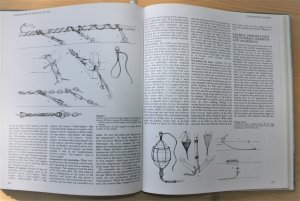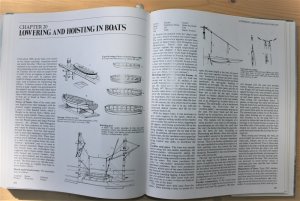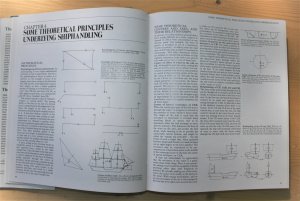Seamanship in the Age of Sail: An Account of the Shiphandling of the Sailing Man-of-War 1600-1860,
By John Harland
Illustrated by Mark Myers


Synopsis:
Numerous successful reprints of contemporary works on rigging and seamanship indicate the breadth of interest in the lost art of handling square-rigged ships. Model makers, marine painters, and enthusiasts need to know not only how the ships were rigged but how much sail was set in each condition of wind and sea, how the various maneuvers were carried out, and the intricacies of operations like reefing sails or 'catting' an anchor.
John Harland has provided what is undeniably the most thorough book on handling square-rigged ships. Because of his facility in a remarkable range of languages, Harland has been able to study virtually every manual published over the past four centuries on the subject. As a result, he is able to present for the first time a proper historical development of seamanship among the major navies of the world.


Contents:
Acknowledgements, Introduction
Chapter 1 SOME WORDS AND PHRASES USED IN SHIPHANDLING UNDER SAIL (page 10 to 18)
Chapter 2 MASTS; RIGGING ANS SAILS (page 19 to 35)
Masts – Yards – Standing Rigging – Running Rigging – Sails and their Gear
Chapter 3 DEVELOPMENT OF THS SAIL PLAN 1580 – 1900 (page 36 to 39)
Chapter 4 SOME THEORETICAL PRINCIPLES UNDERLYING SHIPHANDLING (page 40 to 71)
Mathematical principles – some theoretical cantres and axes, and their relationships – form of the hull and stability – action of wind on the sails – trimming the sails – geometric problems with the rigging – working of the rudder
Chapter 5 SAILS CONSIDERED INDIVIDUALLY (page 72 to 90)
The Cources
Chapter 6 ORGANISATION OF CREW FOR HANDLING THE SHIP (page 91 to 95)
Duties allotted to the different parts of ship – Sail Drill and Working Ship
Chapter 7 BENDING; LOOSING AND FURLING SAIL (page 96 to 123)
Bending square sail – unbending square sail – Bending fore and aft canvas – Loosing sails to dry – Furling Square sails – Loosing fore and aft sail – Furling fore and aft sail – Shifting sails – Sending light yards up and down – Shifting topsail yards – Striking and shifting topmasts – Striking lower yards – Squaring, cockbilling and manning yards
Chapter 8 MAKING AND SHORTENING SAIL AT SEA (page 124 to 136)
Order of making and shortening sail – Shortening sail in bad weather – Handling the individual sails – Disposition of crew for making and shortening sail – the Commands
Chapter 9 REEFING (page 137 to 154)
Methods of Reefing 1600-1900 – other Gear used in reefing – Technique of reefing
Chapter 10 STUDDINGSAILS (page 155 to 172)
Evolution – wind and weather – studdingsails in different points of sail – the sails – other gear used with studdingsails – terminology, English and otherwise – setting studdingsails – the Commands – disposition of crew for handling studdingsails
Chapter 11 STEERING (page 173 to 180)
Chapter 12 TACKING; WEARING AND BOXHAULING (page 181 to 198)
Tacking – sequence of commands – boxhauling – wearing or veering a ship – organization of the crew for working ship – to tack ship – clubhauling
Chapter 13 WORKING SHIP IN A TIDEWAY (page 199 to 202)
Chapter 14 TOWING AND WARPING (page 203 to 208)
Chapter 15 STORM (page 209 to 220)
Preparations – scudding – lying to
Chapter 16 SQUALLS (page 221 to 224)
Chapter 17 HEAVING TO (page 225 to 230)
Chapter 18 THE SHIP AT ANCHOR (page 231 to 279)
General preparations for entering harbor and anchoring – the mechanics of casting anchor – various methods of coming to anchor – management of the ship at single anchor – mooring – general preparation for going to sea – weighing anchor – catting, fishing and stowing the anchor – heaving in – getting under way from single anchor – laying out anchor
Chapter 19 SHIFTING HEAVY WEIGHTS (page 280 to 281)
Chapter 20 LOWERING AND HOISTING IN BOATS (page 282 to 288)
Chapter 21 MAN OVERBOARD (page 289 to 293)
Chapter 22 ACCIDENTS (page 294 to 312)
Accident to running rigging – to standing rigging – to the masts and spars – to wheel and rudder – leaks – running aground – fire
Bibliography, Index
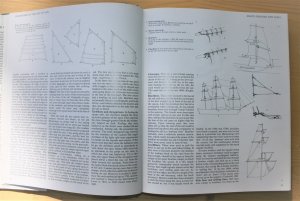

Review: by Brian A. Glennonon in October 11, 2002
'SEAMANSHIP IN THE AGE OF SAIL: An Account of the Shiphandling of the Sailing Man-Of-War 1600-1860, Based on Contemporary Sources'(c.1984) by John Harland, is probably one of the most informative and valuable collections of useful knowledge on sailship handling in the late 20th century!
A major value of this work is its ability to answer the questions developed during today's contemporary square rig sailing. It fully explained why sailboats are pulled by the wind and not pushed (Bernouilli's Principle); the advantages and disadvantages of square rig sailing over fore & aft sailing (downwinds & length of luff); why large square rig ships don't need a center board (a shifting of CLR, CG, & G); or why all sails were never set on a square rig when simply cruising (courses don't draw in a well).
The book is punctuated with pen & ink
drawings as well as period photographs and deguerrotypes of ships in the act of a sail evolution or other shipboard activity. And in a time period where photography was not yet invented, the author used contemporary paintings of vessels to demonstrate an aspect of ship handling. Going further back into history, the author delved into the archeological record to demonstrate the origin or existance of a ship component pertinent to his ship handling argument.
SEAMANSHIP IN THE AGE OF SAIL further provided continuity answers as to why sails are shaped the way they are; or why the steeve of the bowsprit was lessened over time. The book gave valuable points on how to rig a ship while underway; how to rig the stun'sls; how to rig the braces, lifts, tacks, sheets, clews, and bunts; how to raise and lower heavy sails; how to bend sails to the spars; how to box haul or club haul the ship; and why the main topsail halyard is a heart attack waiting to happen.
Just as the serious and ambitious mate or deckhand in the 1700s was caught with a copy of Bowditch ('Practical Navigator') in his seachest; in the 2000s you can watch a mate or an ambitious O.S. walk up the brow to his sailship with a copy of SEAMANSHIP IN THE AGE OF SAIL tucked under his arm. Despite its large size and bulk, this book is well worth taking along into the cramped crews quarters for an informed reading at night.
SEAMANSHIP IN THE AGE OF SAIL is a wonderful archive of esoteric sailship handling maneuvers, equipment, gear, and nautical science. The author has done a wonderful job in his research and has provided a great resource to all sailing ship captains and mates.
This book is intended to complement James Lee´s "Masting and Rigging of the English Ship of War". As Ship modeler it is helping to understand the different important seamanship techniques and it is great source, if you want to assemble sails on your model and this in a correct way. Also very vaulable for diorama builder.
Highly recommended
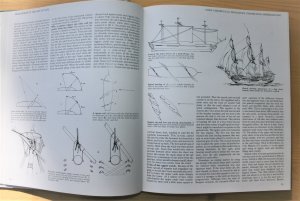
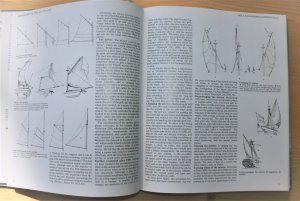


More look Inside photos in the next post
By John Harland
Illustrated by Mark Myers


- Hardcover: 320 pages
- Publisher: Naval Institute Press (January 15, 2016)
- Language: English
- ISBN-10: 0870219553
- ISBN-13: 978-0870219559
- Product Dimensions: 9.8 x 1 x 11.6 inches
- Shipping Weight: 4.2 pounds
Synopsis:
Numerous successful reprints of contemporary works on rigging and seamanship indicate the breadth of interest in the lost art of handling square-rigged ships. Model makers, marine painters, and enthusiasts need to know not only how the ships were rigged but how much sail was set in each condition of wind and sea, how the various maneuvers were carried out, and the intricacies of operations like reefing sails or 'catting' an anchor.
John Harland has provided what is undeniably the most thorough book on handling square-rigged ships. Because of his facility in a remarkable range of languages, Harland has been able to study virtually every manual published over the past four centuries on the subject. As a result, he is able to present for the first time a proper historical development of seamanship among the major navies of the world.


Contents:
Acknowledgements, Introduction
Chapter 1 SOME WORDS AND PHRASES USED IN SHIPHANDLING UNDER SAIL (page 10 to 18)
Chapter 2 MASTS; RIGGING ANS SAILS (page 19 to 35)
Masts – Yards – Standing Rigging – Running Rigging – Sails and their Gear
Chapter 3 DEVELOPMENT OF THS SAIL PLAN 1580 – 1900 (page 36 to 39)
Chapter 4 SOME THEORETICAL PRINCIPLES UNDERLYING SHIPHANDLING (page 40 to 71)
Mathematical principles – some theoretical cantres and axes, and their relationships – form of the hull and stability – action of wind on the sails – trimming the sails – geometric problems with the rigging – working of the rudder
Chapter 5 SAILS CONSIDERED INDIVIDUALLY (page 72 to 90)
The Cources
Chapter 6 ORGANISATION OF CREW FOR HANDLING THE SHIP (page 91 to 95)
Duties allotted to the different parts of ship – Sail Drill and Working Ship
Chapter 7 BENDING; LOOSING AND FURLING SAIL (page 96 to 123)
Bending square sail – unbending square sail – Bending fore and aft canvas – Loosing sails to dry – Furling Square sails – Loosing fore and aft sail – Furling fore and aft sail – Shifting sails – Sending light yards up and down – Shifting topsail yards – Striking and shifting topmasts – Striking lower yards – Squaring, cockbilling and manning yards
Chapter 8 MAKING AND SHORTENING SAIL AT SEA (page 124 to 136)
Order of making and shortening sail – Shortening sail in bad weather – Handling the individual sails – Disposition of crew for making and shortening sail – the Commands
Chapter 9 REEFING (page 137 to 154)
Methods of Reefing 1600-1900 – other Gear used in reefing – Technique of reefing
Chapter 10 STUDDINGSAILS (page 155 to 172)
Evolution – wind and weather – studdingsails in different points of sail – the sails – other gear used with studdingsails – terminology, English and otherwise – setting studdingsails – the Commands – disposition of crew for handling studdingsails
Chapter 11 STEERING (page 173 to 180)
Chapter 12 TACKING; WEARING AND BOXHAULING (page 181 to 198)
Tacking – sequence of commands – boxhauling – wearing or veering a ship – organization of the crew for working ship – to tack ship – clubhauling
Chapter 13 WORKING SHIP IN A TIDEWAY (page 199 to 202)
Chapter 14 TOWING AND WARPING (page 203 to 208)
Chapter 15 STORM (page 209 to 220)
Preparations – scudding – lying to
Chapter 16 SQUALLS (page 221 to 224)
Chapter 17 HEAVING TO (page 225 to 230)
Chapter 18 THE SHIP AT ANCHOR (page 231 to 279)
General preparations for entering harbor and anchoring – the mechanics of casting anchor – various methods of coming to anchor – management of the ship at single anchor – mooring – general preparation for going to sea – weighing anchor – catting, fishing and stowing the anchor – heaving in – getting under way from single anchor – laying out anchor
Chapter 19 SHIFTING HEAVY WEIGHTS (page 280 to 281)
Chapter 20 LOWERING AND HOISTING IN BOATS (page 282 to 288)
Chapter 21 MAN OVERBOARD (page 289 to 293)
Chapter 22 ACCIDENTS (page 294 to 312)
Accident to running rigging – to standing rigging – to the masts and spars – to wheel and rudder – leaks – running aground – fire
Bibliography, Index


Review: by Brian A. Glennonon in October 11, 2002
'SEAMANSHIP IN THE AGE OF SAIL: An Account of the Shiphandling of the Sailing Man-Of-War 1600-1860, Based on Contemporary Sources'(c.1984) by John Harland, is probably one of the most informative and valuable collections of useful knowledge on sailship handling in the late 20th century!
A major value of this work is its ability to answer the questions developed during today's contemporary square rig sailing. It fully explained why sailboats are pulled by the wind and not pushed (Bernouilli's Principle); the advantages and disadvantages of square rig sailing over fore & aft sailing (downwinds & length of luff); why large square rig ships don't need a center board (a shifting of CLR, CG, & G); or why all sails were never set on a square rig when simply cruising (courses don't draw in a well).
The book is punctuated with pen & ink
drawings as well as period photographs and deguerrotypes of ships in the act of a sail evolution or other shipboard activity. And in a time period where photography was not yet invented, the author used contemporary paintings of vessels to demonstrate an aspect of ship handling. Going further back into history, the author delved into the archeological record to demonstrate the origin or existance of a ship component pertinent to his ship handling argument.
SEAMANSHIP IN THE AGE OF SAIL further provided continuity answers as to why sails are shaped the way they are; or why the steeve of the bowsprit was lessened over time. The book gave valuable points on how to rig a ship while underway; how to rig the stun'sls; how to rig the braces, lifts, tacks, sheets, clews, and bunts; how to raise and lower heavy sails; how to bend sails to the spars; how to box haul or club haul the ship; and why the main topsail halyard is a heart attack waiting to happen.
Just as the serious and ambitious mate or deckhand in the 1700s was caught with a copy of Bowditch ('Practical Navigator') in his seachest; in the 2000s you can watch a mate or an ambitious O.S. walk up the brow to his sailship with a copy of SEAMANSHIP IN THE AGE OF SAIL tucked under his arm. Despite its large size and bulk, this book is well worth taking along into the cramped crews quarters for an informed reading at night.
SEAMANSHIP IN THE AGE OF SAIL is a wonderful archive of esoteric sailship handling maneuvers, equipment, gear, and nautical science. The author has done a wonderful job in his research and has provided a great resource to all sailing ship captains and mates.
This book is intended to complement James Lee´s "Masting and Rigging of the English Ship of War". As Ship modeler it is helping to understand the different important seamanship techniques and it is great source, if you want to assemble sails on your model and this in a correct way. Also very vaulable for diorama builder.
Highly recommended




More look Inside photos in the next post
Attachments
Last edited:






